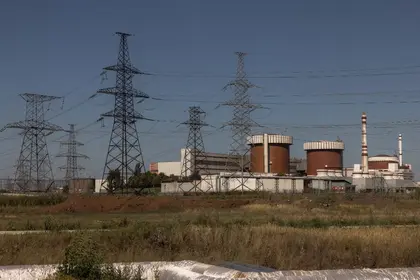The complete destruction of the Trypillya power plant on the morning of April 11 came after a series of similar attacks on Kharkiv, Chernihiv, Kyiv, Mykolaiv, Sumy and other regions’ energy facilities. Russia has been systematically targeting such sites for almost a month now. Notwithstanding the devastation to communities – the destruction or severe damage to all major Ukrainian power plants has made many contemplate how Ukraine is going to rebuild its energy assets during – and following – the war.
In late November 2022, just a few weeks after the first Russian attacks on Ukraine’s energy infrastructure, our firm was approached by a foreign energy engineering company looking to buy a local Ukrainian counterpart. The underling strategy was evident – the more Russia bombed the Ukrainian power plants, the more reconstruction would be needed afterwards. This presents business opportunities for companies like the one that came to us.
JOIN US ON TELEGRAM
Follow our coverage of the war on the @Kyivpost_official.
Scale of the damage and recovery opportunity
Since the beginning of Russia's full-scale invasion, the energy sector has suffered more than $10 billion in damage due to relentless attacks. Those in the fall and winter of 2022-2023 reduced the national electricity production capacity by 61 percent. Following the latest attacks on March 22-24, over 50 percent of the production capacity of DTEK, the largest private energy company, was damaged, which will now take months to recover. According to Volodymyr Kudrytskyi, head of NPC "Ukrenergo," Russia's latest attacks caused at least €100 million in damage to Ukraine's energy system.

‘We Need to End that Horrible, Horrible War’ – Ukraine at War Update for Dec. 23
But even under the continuous threat of attacks, Ukraine continues to reconstruct its power, gas, and heating networks.
In 2023, the state Energy Support Fund accumulated over €400 million, mainly for purchasing the most critical equipment. The G7+ Ukraine Energy Coordination Group, created in June 2023, coordinates and mobilizes donors to fix, rebuild, and protect the Ukrainian energy infrastructure system. Its last meeting was convened on March 28 after the most severe blows to the Ukrainian energy sector, in which the partners confirmed their commitment to assist Ukraine in recovering from Russian attacks.
As for Ukraine's state expenditure, the budget for 2024 provides Hr. 863 million ($21.2 million) for the reconstruction of energy infrastructure. Ukraine’s private sector doesn’t fall short. In 2023, DTEK, Ukraine’s largest private energy group, invested about Hr. 11 billion ($300 million) in thermal power plant repairs and coal mining, almost twice as much as a year earlier.
Renewables
According to the Ukraine Investment RoadMap 2024, the focus of the Ukrainian government and foreign investors is now shifting towards renewables: small and medium power plants spread across the whole country are much more difficult targets to hit with drones and missiles.
In 2023, Ukrainian businesses invested about $150 million in solar energy.
The country has adopted a "build back better" approach, focusing on renewable energy sources, fostering closer ties with the EU, and creating opportunities for international investments.
Ukraine’s plan to generate 50 percent of its power from renewable sources and 50 percent from nuclear energy by 2035 indicates its strategic path towards net zero emissions. Despite the war, Ukraine is successfully moving in this direction. According to Andriy Gerus, head of the Energy Committee in the Ukrainian parliament, several new power generation facilities were brought into action in 2023, including wind power plants with a combined capacity of 182 megawatts and
solar power plants totalling 500 megawatts of capacity (mostly for individual consumers).
Most of the new generation facilities have a capacity of 1 megawatt or less. The largest new power plant operational in 2023 was DTEK’s Tiligulska wind farm, located in the Mykolaiv region, with a generation capacity of 78 megawatts. Due to new green energy capacity, Odesa oblast managed to get rid of regular blackout schedules in 2023.
Foreign investment potential
Currently, most reconstruction work is undertaken through aid rather than investment.
In January 2023, USAID announced an additional $125 million in urgent energy support for Ukraine in response to the first severe attacks on critical infrastructure. The US provided over $53 million for critical electricity grid equipment, including distribution transformers, circuit breakers, and other key components. A total of $55 million in aid was dedicated to emergency energy sector support, and restoring power and heat to local municipalities impacted by Russia’s attacks.
Strategically, Ukraine's energy sector offers significant investment opportunities, particularly in its green energy transition, which is aligned with EU strategies. Based on research conducted jointly by the United Nations Development Programme (UNDP) in Ukraine and UkraineInvest, the energy efficiency sector in Ukraine has investment potential exceeding $27 billion.
At the Ukraine Recovery Conference, the Ministry of Economy of Ukraine, together with Advantage Ukraine, showcased an investment portfolio worth $67 billion. This includes 36 projects dedicated to “green energy,” totalling $25 billion, although there is not yet any evidence of the investments completed within this portfolio.
Additionally, Ukraine is advancing its nuclear energy capacity with plans to start building four new reactors at the Khmelnitsky Nuclear Power Plant in 2024. In September 2023, the President of the European Bank for Reconstruction and Development (EBRD), Odile Renaud-Basso, expressed the organization’s readiness to invest approximately €1.5 billion annually within two years.
The main focus of foreign investors in Ukraine’s energy sector now is renewables.
The most recent publicly announced industry investments include the Cypriot company GNG Retail Limited, which owns the OKKO Group, taking over Wind Power GS I Volyn and Wind Power GS I Volyn 3. The fuel company plans to develop a wind power project capable of generating 150 MW in the Volyn region.
Risk mitigation in wartime
While investors’ appetite is growing, the lack of sufficient insurance mechanisms for war risks in light of potential new attacks on infrastructure, remains the main challenge. As of now, standard insurance covers only traditional risk perils such as fire, theft, and natural disasters, and excludes war risks. Traditional global development banks and development finance institutions offer limited risk mitigation tools. Private insurance is either non-existent or expensive, with premiums starting from 10 percent. Ukraine needs around $5 billion in war insurance provisions for 2023 and 2024, with an acceptable premium range of 1-4 percent.
According to UkraineInvest, the European Bank for Reconstruction and Development (EBRD) is working on a multi-hundred-million euro war risk insurance mechanism involving the Ukrainian insurance market and European Commission guarantees. EBRD, the European Commission, Norway, Switzerland, and TaiwanBusiness signed a statement of intent in June 2023.
To incentivize private sector investment, Ukraine needs policy reforms and regulatory improvements. Experts propose an international guarantee scheme for war risk insurance, which should be governed by a special vehicle with robust corporate governance. It must be funded by international donors and implemented in collaboration with a consortium of global reinsurance companies. Ukrainian government leadership is valuable at the conceptual stage for determining eligibility criteria and during implementation for supervision and transparency.
Expectations for 2024
Ukraine's energy sector is expected to attract around $11.5 billion to add 5–10 GW of renewable energy up to 2032. In 2024, Ukraine will be focusing on developing green energy facilities in regions far from the front line, as currently available resources are primarily located in five frontline regions: Odesa, Zaporizhzhia, Mykolaiv, Kherson, and Dnipro. The UNDP's report on Supporting Green Bond Development in Ukraine emphasizes mechanisms for financing green projects, selecting and monitoring these projects, reporting standards, and issuing incentives.
Global financial institutions, including the EBRD, are expected to support the development of a Ukrainian green bonds market by establishing regulatory and legal guidelines, supervising mechanisms for financing green projects, and setting standards for evaluating, monitoring, and reporting on these projects.
However, a number of challenges remain, such as the requirement for substantial financial assistance, insufficient development of renewable energy sources compared to traditional ones, political reforms, and recovery from physical destruction in conflict-affected places.
According to the World Bank, as of March 2023, an estimated $45 billion was still needed to fully restore Ukraine's energy system. There is no more recent data on that requirement, but the number announced one year ago is likely to be much higher now.
While causing damage to Ukraine’s energy system, the Russian invasion has also pushed the country to accelerate its transition to renewables, which in some cities and regions like Odesa even helped local authorities avoid recurring blackouts. It has also raised anticipation of all global industry players towards major reconstruction, which will become one of the key cornerstones of Ukraine’s recovery once the war is over.
You can also highlight the text and press Ctrl + Enter









